Borne on the Wings of History
Beth Hinchliffe writer
Peter Baker photographer
Historic images courtesy of the Wellesley Historical Society
 It’s dark and crowded in the basement of the Wellesley Historical Society, just as you’d expect the tombs of the town museum to be. You make your way down creaking steps, around a hulking oil tank and under low-hanging pipes, then turn sideways to edge between heavy trunks and racks of gowns and crates piled to the ceiling. To the right, you reach worn wooden cabinets crammed together in a tight space dimly lit by a distant overhead light.
It’s dark and crowded in the basement of the Wellesley Historical Society, just as you’d expect the tombs of the town museum to be. You make your way down creaking steps, around a hulking oil tank and under low-hanging pipes, then turn sideways to edge between heavy trunks and racks of gowns and crates piled to the ceiling. To the right, you reach worn wooden cabinets crammed together in a tight space dimly lit by a distant overhead light.
And then you pull open one of the cabinet’s drawers and everything changes.
In a ferocious blaze of colors drenched with impossibly bright internal sunlight, in patterns that would make Jackson Pollock proud, the nearly 1,500 butterflies and moths nestled inside the drawers do more than illuminate the shadowy room. Lighter than a breath, more iridescent than a tropical rainbow, they look as if they had just fluttered into the basement a soft moment ago.
Yet they have rested in their cases for more than a century. Living only a few brilliant days in the world, these lepidoptera have been preserved without a fading of their glory by one astounding Wellesley family.
At the turn of the 20th century, the legend of the Dentons reached around the world. They won the gold medal at the 1900 Paris Exhibition; they traveled four continents lecturing, collecting, and exhibiting. Parisian couturier Worth based a line of gowns on their displays; Louis Comfort Tiffany tried to buy their secrets for his jewelry and stained-glass; the scientific world heralded and awarded their innovations. Their exhibits took up permanent homes in millionaires’ estates, museums, and universities throughout Europe and the United States.
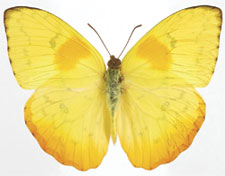
Catopsilia Philca (Brasil)
And yet now, out of the hundreds of thousands of little beauties that enchanted the Victorian and Edwardian eras, the ones that slumber in the Historical Society may be the only Denton butterflies left to be seen. Who was this family, and how did they achieve their stunning success?
The legend starts with William, born in 1823. Iconoclastic, rebellious, utterly individualistic, he was a self-taught scientist, lecturer, naturalist, collector, and explorer. He would have been the quintessential American icon: except that he was British. But he then became more American than the Americans, because in 1848, after he lost his London teaching job for his radical and “heretical” beliefs, this unschooled boy who had become a maverick preacher at age 16 abandoned his native land in search of the vast intellectual, religious, cultural, and physical freedoms beckoning from across the ocean.
Soon he was even driven from his West Virginia teaching job by the threat of mob violence for his passionate abolitionist views, so he fled to anti-slavery Ohio, where he was once asked to provide safe escort from an angry crowd to Elizabeth Foote, known for her progressive writings, her daring to take a “man’s” job as a typesetter, and her shocking propensity for wearing bloomers.
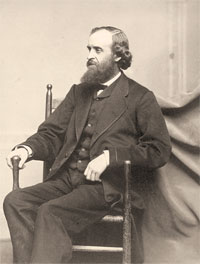
William Denton, Sr.
These two fruitfully kindred spirits soon joined forces, marrying and launching the kind of extraordinary Mark Twain/Horatio Alger life possible in this bold progressive era. They traveled the country writing, speaking, absorbing. There didn’t seem to be a subject William did not have an interest in, or an opinion on. He published and lectured about geology, scientific enlightenment, women’s rights, free-thought, spiritualism, and industrial and societal reforms. He engaged in a week-long debate about evolution with future President James Garfield. A lifelong rabid teetotaler, on his non-stop lecture tours he railed passionately in favor of temperance. Inspired by his fascination with the clairvoyant world, he invented a new field called “Psychometry,” and set about to convince others that a spiritualist (such as Elizabeth) could read the memories of everything that a stone or fossil had ever seen.
For the next 10 years, they were an inseparable team on the small-town itinerant lecture circuit, one year walking 9,000 miles to deliver 255 lectures. Along the way they collected pieces of the natural world compulsively—minerals, gems, granite, bird skins, fresh water pearls, fossils—and, of course, butterflies.
When it came time to create the next generation of insatiably curious naturalists, William and Elizabeth bought a homestead, but for the rest of William’s compulsively single-minded life of exploration, he never settled down. In 1867, they bought 13 acres of cleared cornfield stretching north from today’s St. Andrew’s Church, in what was then the rural, purely country village of West Needham, now Wellesley. The land was reached by a rutted path known as Orchard Street, later named Denton Road. They built one of the largest homes in the area at what would become number 11, and set about raising five children who spent most of their days exploring the natural world around them — catching fish with their bare hands in Waban Brook; finding Indian arrowheads and large stone pestles in the fields that would become the Nehoiden Golf Course; collecting bird eggs along Fuller Brook; always coming back with bits and pieces of nature to study and dissect and draw and discuss.
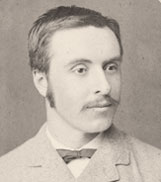
Sherman Denton
The four boys walked to school on Central Street and joined the town band; the daughter had Katharine Lee Bates as a teacher. But when they became teenagers, William took them out of school and enlisted them as his magic lantern assistants on his itinerant tours, which now lasted for years at a time. In 1881, just as Wellesley became a town, William and sons Sherman and Shelley left for a three-year tour of Australia, New Zealand, and Tasmania. While there, in 1883 William couldn’t resist a chance to plunge deep into the intoxicating “terra incognita” of New Guinea. Stricken with jungle fever, he couldn’t make it back to his sons who waited in a coastal village, and he died 15 miles away from reaching them. He was 60 years old.
His children inherited his restless natural curiosity, but also his massive bills and responsibilities. Bringing back with them tens of thousands of pounds of fossils, bird eggs and skins, fish, snakeskins, insects, stones, and butterflies, they desperately had to find a way to combine their father’s legacy with the practical demands he had never mastered.
The five children, four wives, mother, and three grandchildren bonded into an extraordinary single unit, working as one to share their lives and work. They all lived on the family property, building their own homes and the still-standing barn at number 72 to store their accumulated treasures. Upon William’s death, Sherman, the oldest at 27, turned his family’s undisciplined collecting into a focused and thriving business. He looked at the thousands upon thousands of butterflies which they had shipped home and developed and patented a process to preserve these fragile bits of beauty. Now the Dentons could bring a kind of immortality to what had before been merely momentary glimpses of a rare loveliness.
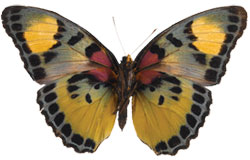
Euphaedra Sarcopterfa (Africa)
Sherman’s design was innovative, leading The New York Times in 1895 to gush over what was called the “Denton Mount”: “The wings of the fragile creatures rest against a background like alabaster, showing every minute curve and scallop. Yet they are protected from dust and pests, and may be handled without fear of breakage.” Until now, researchers had stretched butterflies into awkward shapes, impaled them with pins, and doused them with foul chemicals, and yet they still quickly faded and crumpled. Sherman’s plaster mount cradled the fragile bodies in a tender, natural embrace, encased them in glass, and transformed them into centerpieces of scientific and cultural delight.
That same year Willie and Winsford transformed the barn into headquarters for “Denton Brothers Butterflies” and, using Sherman’s creation and the immense amount of butterflies the family had brought back over the years, went into business. At their first Boston exhibit, the Heraldproclaimed: “No flies on the butterfly show,” which was judged “wildly successful.” Shelley, the fourth brother, came onboard and brought 500 samples to the American Art Gallery in New York where they captivated the Victorian fascination with nature and became the “must-have” collectible item of the decade. The millionaire railroad czar C.P. Huntington bought the entire collection, and used them to decorate the walls of his yacht. Soon, the brothers were traveling the country to launch their exhibitions and could scarcely keep up with the demand of orders from around the world: collectors, institutions, designers, even governments wanted Denton butterflies. The younger brothers traveled the world half the year to re-stock; then the other half produced and shipped their treasures.
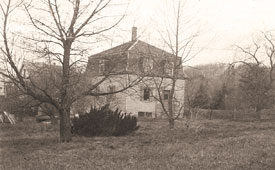
The Denton’s Butterfly Shop, 72 Denton Rd.
The demand from Great Britain was particularly insatiable, so in 1897 Shelley opened a shop on Regent Street in London. He almost didn’t make it. The S.S. Londonian, carrying 22,000 butterflies and the mounts sank, and all was lost. Undaunted, he crossed the ocean four times to replenish his collection, and soon was supplying the newly fashionable items not only to lords and dukes, but also to most of the museums in Great Britain, including the British Museum. His show at the Rembrandt Gallery in London broke records.
The timing was serendipitous. The Dentons’ singular hobby fit ideally with the preoccupations and fascinations of the Victorians, many of whom were obsessed with the natural world and with memento mori,and who yearned to fill every wood-carved nook and bookcased-cranny of their homes with the most unique and talked-about collectibles.
And then came the 1900 Paris Exhibition, a world’s fair unlike any the world had ever seen. Designed “to showcase the greatest innovations of the previous century and preview the new century’s achievements,” it drew more than 50 million people and 76,000 exhibitions to the banks of the Seine. The Grand Palais and the Musée d’Orsay were built just to house it. Here were the first glimpses of talking films, escalators, Art Nouveau, and the diesel engine.
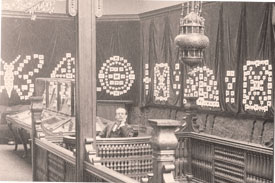
The Denton Brothers’ first butterfly exhibition at the American Art Gallery in New York City (Shelly seated).
And the Dentons’ butterflies. Against the backdrop of other loud and showy displays, their understated beauty seemed unthinkably delicate, subtle and as fragile as a whisper. And yet, the modest young men from Wellesley stormed the Bastille in their own way, as theirs became one of the most popular attractions. When the judging was finished, the Dentons had won the gold medal.
Now everyone wanted Denton butterflies. As the great Parisian couturier Worth left the Exhibition he announced that he was designing a line of gowns inspired by the butterflies’ brilliance. Elbert Hubbard, instrumental in the creation of the turn-of-the-century Arts and Crafts movement, bought samples and talked of their influence upon his style. The next year, when Queen Victoria died and Great Britain stood still in mourning, Shelley Denton was asked to use his techniques to preserve the symbolic flowers that topped her coffin. Later, for the 13th birthday of the young boy who would become Edward VIII and then abdicate his throne for the woman he loved, the palace commissioned the Dentons to prepare a coming-of-age gift: a collection of every butterfly and moth native to the British Isles. The boy was enthralled, and decades later still bought butterfly jewelry for his beloved Wallis Simpson.
Back home, Willie and Winsey expanded their business by developing a technique to make jewelry. Painstakingly, they mounted butterflies no larger than a pencil tip on the background of a startlingly colored piece of wing, and encased them in lockets, brooches, earrings, and stickpins. Fashionable streets came ablaze with butterflies that seemed to have landed on lapels and the brims of extravagant hats. Louis Comfort Tiffany tempted the Denton brothers with wealth and fame by asking them to sell him the secret of this jewelry, but they never considered his offer, for it was a part of the family legacy.
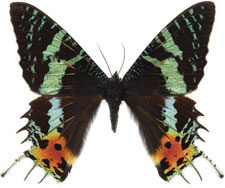
Urania Ripheus (Madagascar)
Now, however, the startling brilliance of the Dentons and most of their butterflies have faded away. Collecting butterflies is no longer in fashion, and that fin-de-siècle spirit of sheer adventurism has disappeared. Technology has made the techniques that were so extraordinary in the 1800s now seem outdated and quaint. None of William’s grandchildren married, and when the last one died at the family homestead in 1969 the world had long since stopped coming to Denton Road to see the brothers’ museum.
That Denton granddaughter left the brothers’ personal collection to the Wellesley Historical Society, where it has safely slumbered for more than 40 years, a reminder of a time when its mere existence was sheer wonder. The only one remaining of the poignantly evocative collections that once filled the worlds’ museums and universities, it still has the power to captivate a 21st-century viewer as it did her great-grandparents.
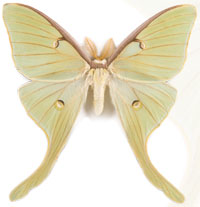
Actias Luna (Massachusetts)
Age has not withered, nor custom staled, their infinite variety. Some of the butterflies are as tiny as a thumbnail; some cover your whole hand. Some are splashed with vibrant patterns as abstract as modern art; some look like glittering, feverish eyes; many are drenched with brutally brilliant colors. Like gossamer snowflakes, no two are alike. With each slight turn their colors fade and intensify and mysteriously shift, each one a magic show in a tiny glass box. They are the canvas of nature’s art.
They speak of subtle and unknowable mysteries, these visitors from the South American jungles, who were meant to be seen for a few days only, and not by human eyes. But instead of disappearing into the banks of the Amazon in the 1800s, they are still here. They look as if they’d dissolve if you exhale too heavily, and yet they are stronger than any of us, for they are still here after more than 100 years, poised as if they’ll dart off again in an instant, with a shimmer and a dance of their wings. In their hometown they are ours, still mesmerizing just as they mesmerized the Denton boys, who brought them home to share with the world and now, just with us. ![]()
(You are welcome to visit the Wellesley Historical Society to meet the butterflies and experience the legend of the Dentons; call curator Kathleen Fahey at 781.235.6690, or e-mail her at kathleen.fahey@wellesleyhistoricalsociety.org.)
© 2011 Elm Bank Media | Beth Furman, Publisher | Beth@ElmBankMedia.com

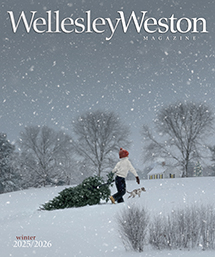
recent comments